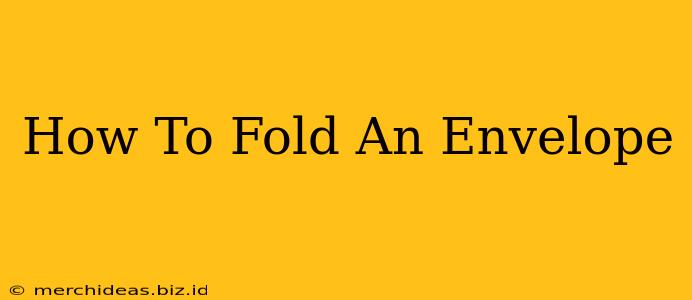Sending a handwritten letter or a card is a thoughtful gesture in our increasingly digital world. But before you can share your message, you need to know how to fold an envelope properly! This seemingly simple task can be tricky if you haven't done it in a while. This guide will walk you through different envelope folding techniques, ensuring your correspondence arrives safely and looks professional.
Different Envelope Sizes and Folding Techniques
The method for folding your letter depends largely on the size of your envelope and the size of your paper. Generally, you want your folded letter to fit snugly inside the envelope without being crammed or overflowing.
Standard #10 Envelope (Business Envelope)
This is the most common type of envelope used for business correspondence. The standard size is approximately 4 1/8 inches by 9 1/2 inches. Here's how to fold a letter to fit:
- Fold in thirds: First, fold the top third of the paper down towards the center. Crease sharply.
- Fold the bottom third: Next, fold the bottom third of the paper up to meet the top fold. Crease sharply again. This creates a neat, three-panel fold.
- Insert into envelope: Insert the folded letter into the envelope with the open end facing upwards.
A2 Envelope (Common for Invitations and Cards)
A2 envelopes are slightly larger than #10 envelopes, approximately 4 3/8 x 5 3/8 inches. The folding method is slightly different:
- Fold in half: Fold the paper in half lengthwise, bringing the bottom edge to the top edge. Crease sharply.
- Fold in half again: Fold the paper in half again, bringing the top edge to the bottom edge. Crease sharply.
- Insert into envelope: Slip the folded letter into the envelope.
Larger Envelopes (For larger documents)
For larger envelopes, you might need to adjust the folds to accommodate the size of your paper. The key is to ensure the folded letter fits neatly and doesn't bulge. You can adapt the above methods by folding the paper into more than thirds or quarters, as needed.
Tips for Professional-Looking Envelope Folding
- Sharp creases: Make sure to crease your folds sharply. This will keep your letter neatly folded and prevent it from looking rumpled. You can use a bone folder or even just your fingernail to create crisp creases.
- Neatness: Take your time and aim for neat, even folds. A well-folded letter reflects attention to detail.
- Envelope Alignment: Make sure the address on the envelope is upright and clearly visible.
Beyond the Fold: Addressing Your Envelope
Once your letter is folded, it's time to address the envelope. Proper addressing is crucial to ensure your mail arrives safely and efficiently. Remember to include:
- Recipient's Full Name and Address: Double-check the spelling!
- Your Return Address: This allows the post office to return the letter to you if it cannot be delivered.
- Clear and Legible Handwriting (or Typed Address): Ensure the address is easy for the postal worker to read.
Mastering the art of envelope folding might seem insignificant, but it adds a touch of professionalism and care to your correspondence. By following these steps, you can confidently send your letters and cards knowing they will arrive looking their best. Now get folding and share your heartfelt messages!
